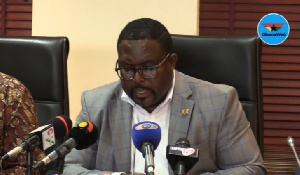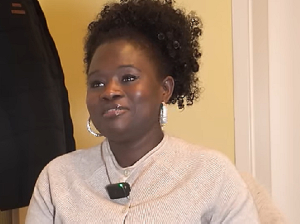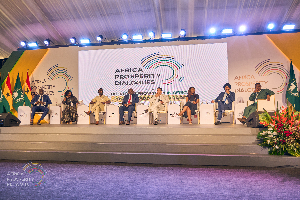A GNA Feature by Lawrence Quartey
Anytime I witness the disgrace and humiliation being meted out to the country’s lowest currency denomination, the one pesewa (1Gp), it reminds me of the popular local adage which says: “In every house there is a “Mensah” Ghana’s 1Gp, which is suppose to help smoothen transactions, has now become the “Mensah” among its siblings – the 5Gp, 10Gp, 20Gp, GH¢1 coins as well as the GH¢2, GH¢5, GH¢10, GH¢20 and GH¢50 notes.
It has become the “bad nut in our soup” that every household “fishes” out in order not to spoil the entire good soup. Yet in the eyes of the parent or the soup owner (that is the Bank of Ghana), the 1Gp coin remains precious and important ingredient to give the soup the perfect of taste.
So why the dislike for the 1Gp, especially when the front (that is the obverse) of each of the coin is a different image symbolizing some aspect of the Ghanaian heritage and tradition.
The 1Gp has an image of the Adomi Bridge, indicating the significance of infrastructure and freedom of movement of goods and people in a united Ghana.
“In addition to these images, user requirements including fitting the wallet ease of banknote automation and features for the visually impaired were incorporated in the design,” these were the description of the central Bank of Ghana during its naming ceremony.
The situation is pathetic considering its economic implications to Ghana’s currency management vis-à-vis the control of inflation, number one enemy of every state. Peoples’ incomes are decreasing at an increasing rate, yet many are not aware they are losing so much. Even those who are aware of the implication, say the impact on their incomes is negligible.
You enter a financial institution to withdraw money or cash a cheque or exchange foreign currency, and the cashier sees nothing wrong to paying you less the amount. He or she clad in designer suit or other expensive apparel, comfortably looks at you with a captivating smile and say to you “I don’t have the lowest denomination”. Any change below 5Gp is denied you.
But what is more interesting, is that when a “generous” cashier finds you the 1Gp coins to give the full amount requested, the customer knowing the coins will not be accepted if he decides to transact business with them, leaves the banking hall and hurls them away.
Perhaps, the cashiers do the right thing by denying customers the full amount. But maybe not for Okpoti’s 74 year grandmother - “I will keep every last penny of coin so long as it is legal,” she says when I had the privilege to ask her opinion of the 1Gp coin.
Observing such a disturbing phenomenon just after coming out from a banking hall (name withheld) in Accra in September this year, presented the idea to embark on a project.
The project was to help save the 1Gp of Shame and Torture from the very people who wield the power to save it. Currency protection is a responsibility of all - Not only the central bank and financial institutions. The Citizens, most especially have the responsibility to protect it.
Less than three after initiating the project, together with the help of others, I manage to collect 55Gp. These coins were found mainly on the floors at the outer-spaces of financial institutions, lorry parks and market centres. You may be saying this does not mean anything in terms of value – but please consider the cost of production and implications on our economy.
Ghanaians, unfortunately do not like the 1Gp. Is it their fault? The answer is certainly a big no. Why? - Because it is no longer considered a medium of exchange among majority of the populace though it is still a legal tender.
Sampling the views of 20 people on why people don’t like the 1Gp coin, almost all at the Tema Lorry Station and the Circle Kaneshie Lorry Station in Accra, mentioned two important factors – because of it the Colour and Size.
To them the brown colour of the 1Gp coin is not attractive, it’s different and not as nice as the others, which is silver in colour. They said the size is also too small to carry, hence its rejection. Please remember that “Mensah” in every home always have something that the others do not like. So the 1Gp is the odd one out.
While undertaking the project, I sat in a trotro (commercial bus) from La to Accra recently, and there in the bus was the sordid spectacle of what can be described as another face of the 1Gp humiliation.
Strange and sadly enough, I found no single well-meaning Ghanaian in the commercial vehicle of about twenty four people (including myself), who could stand out to defend the legal tender of the new 1Gp coin. Pardon me, because I had no choice so I joined the band wagon.
This is after a well-dressed gentleman in tie had refused to accept the coins as change from the driver’s mate in the same “trotro” he boarded from Teshie to Accra.
It took me about five minutes to listen to the row before I realised that the noise and attacks in the vehicle were not being heaped on a person but on the lowest denomination of Ghana’s redenominated one Ghana pesewa coin.
Surprisingly, the other passengers, amidst anger and laughter jumped to the defence of the gentleman and utterly condemned the 1Gp coin – They “proved” in their own rights why and how the new pesewa coin had become useless and therefore had ceased to be legal tender in the Ghanaian market. So why on earth should the mate use the coins as change to anyone?
The driver’s mate gripped with fear and realizing that his master (driver) did not even come to his defence, decided to collect back the coins and apologized for using the coins as change to the gentleman in tie. “I gave those ones to him because I don’t have the five pesewa coin on me,” the poor mate begged.
But soon after he had collected the coins back, he said: “Didn’t you Ghanaians ask for it. Why are you now rejecting it”? This made him sigh a little because no one responded this time.
When the bus reached its final destination at the Tema Lorry Station, the gentleman, prior to leaving, remarked: “Even if I should see fifty of those coins scattered on the floor, I will not waste my precious time to collect them.”
An elderly woman of about 50 years, who also joined, said: “But it’s true. We see the one pesewa coins on the floor every day and nobody collect them because people don’t even accept them as money.”
The Bank of Ghana (BOG) on March 3, 2007 launched the Ghana cedi notes and coins and the Ghana pesewa coins as a monetary measure to underpin the regime of stability at the time.
The Governor at the time, Paul Acquah said: “this exercise should not be seen as just another currency exchange exercise but rather an important means of promoting efficiency in the way business is done in Ghana.
The new currency was to allow the domestic currency (the cedi) to assume its role as the means of exchange and store of value for all, both within and outside the banking system in a stable low inflation environment.
Soon after the launch, the bank embarks on public education to prepare Ghanaian to its introduction on July 3, 2007. The education was dubbed: “Know Your Notes and Coins and Security Features”.
Through visual presentations on television stations, posters as well as the Direct Community Contacts, the education became successful.
The bank launched a special website on re-denomination and organized seminars. Under the Direct Community Contact program, the Information Services Department (ISD) and the National Commission for Civic Education (NCCE) undertook direct contacts with the communities in all the 138 districts of the country to reach those in the rural areas.
There was no doubt that significant progress was made in carrying out the educational campaign. The family of the notes and series of coins was designed to pay tribute to some key personalities for their contribution to the social, political and economic development of our great nation.
Today, having used the new currency for about four years, it’s important that some assessment is done, which is what this article is about. It will be important to hear the central bank’s own assessment of the public on the use of the 1Gp coin.
It will also be relevant to know how much of the 1Gp has been injected so far into the economy and its cost to the nation; whether the BOG continues to introduce the 1Gp coins; and what impact the 1Gp had had on inflation over the years considering the fact that price increases in the market usually rounded up to the five pesewas coin.
In other economies, some currencies that previously had subunits (like the 1Gp and the 5Gp) no longer do, because inflation has rendered the subunit useless. A prominent example is the Japanese yen, which was formerly divided into 100 sen or 1000 rin. Both subunits were demonetized.
Smaller currency units or subunits makes pricing in an economy easy and thus ensure that the price movements are reasonably done. Maintaining an adequate supply of notes and coins in circulation is a significant role of central banks
In his article “Modeling the Currency Issue,” Jerry Mushin said Inflation may reduce the durability of coins as circulating money below their physical durability.
“As prices rise, the value of coins as money may fall below the value of their metal content and, in this situation, it is likely that coins will be melted down and sold for industrial use and the number circulating as money will diminish.”
Therefore, during a period of inflation, Mushin suggested that reducing the weight of coins, while not changing their physical durability, would increase their durability as money (and also increase their cheapness).
“If the cumulative effect of inflation is substantial, the real value of low-denomination coins as money may become trivial and their durability as money may become zero. This process may be hastened or confirmed by the administrative decision of demonetization,” he said.
Opinions of Monday, 26 December 2011
Columnist: GNA
Ghana’s One Pesewa Coin deserves respect and fair trial
Opinions

















